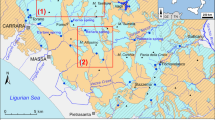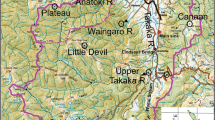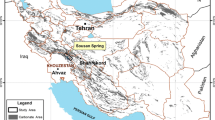Abstract
Karst aquifers typically have desirable physicochemical properties and can provide an important source of groundwater for drinking. Kiyan karst springs, located in the geological region of the Zagros (western Iran), consist of two springs (Keder and Zolal) situated 3 m apart. The water of Zolal spring is always clear, with no turbidity during rainfall or earthquake phenomena, but Keder spring, which also provides drinking water to a city of 10,000 inhabitants (Kiyan city), has very high turbidity in these conditions. This situation disrupts the drinking water supply for about 1 month per year in the study area. The interpretation of discharge time series diagrams, precipitation, and turbidity in different rainfall and earthquake conditions, composite diagrams, and stable isotope concentrations show this study area to be a well-developed karst environment with a highly eroded tectonic zone and large karst conduits along with turbulent water flow. In general, the difference in the behavior of the two springs is related to different paths of water movement through the drainage area. The two springs share the same source of recharge from rainfall and the same initial underground drainage path from the largest sinkhole in the region; although the path of water movement is divided into two branches, with Zolal spring water entering a narrower fault channel. In the Zolal spring pathway, a siphon-shaped reservoir is formed where muddy rainwater settles, so that the water from this spring is clear but has higher concentrations of some ions analyzed here than Keder spring water.















Similar content being viewed by others
References
Ashjari J, Raeisi E (2006) Influences of anticlinal structure on regional flow Zagros Iran. Cave Karst Stud 68(3):118–129
Amil A, Avc P, ÇilA MA, NurÖzyurt N (2020) Significance of validation for karst aquifers’ vulnerability assessments: Antalya Travertine Plateau application. Contaminant Hydrol 228:1–13
Amraoui F, Razack M, Bouchaou L (2003) Turbidity dynamics in karstic systems: Example of Ribaa and Bittit springs in the Middle Atlas (Morocco). Hydrol Sci 48(6):971–984
Bannezhad H, Mohebzade H, Ghobadi M, Heydari M (2011) Numerical simulation and pollution transit in groundwaters, Case study: Nahavand aquifer. J Sci Water Water 23(2):43–57
Bakalowicz M (2005) Karst groundwater: a challenge for new resources. Hydrogeology 13:148–160
Bayari CS, Nur Ozyurt N, Kilani S (2009) Radiocarbon age distribution of groundwater in the Konya Closed Basin, central Anatolia, Turkey. Hydrogeology 17:347–365
Bauingenieur G (2014) Drainage structures and transit-time distributions in conduit-dominated and fissured karst aquifer systems. PhD thesis in Karlsruher Instituts für Technologie (KIT). 160 p
Bicalho CC, Batiot-Guilhe C, Taupin JD, Patris N, Van S (2016) A conceptual model for groundwater circulation using isotopes and geochemical tracers coupled with hydrodynamics: A case study of the Lez karst system. France Chem Geol 528:118442
Bouchaoua L, Manginb A, Chauvec P (2002) Turbidity mechanism of water from a karstic spring: example of theAin Asserdoune spring (Beni Mellal Atlas, Morocco). J Hydrol 265:34–42
Clark I (2015) Groundwater Geochemistry and Isotopes, 1st edn. CRC Press, Florida
Cholet C, Steinmann M, Charlier J, Denimal S (2019) Characterizing fluxes of trace metals related to dissolved and suspended matter during a storm event: application to a karst aquifer using trace metals and rare earth elements as provenance indicators. Hydrogeol J 27(1):305–319
Field M (2021) Groundwater sampling in karst terranes: passive sampling in comparison to event-driven sampling strategy. Hydrogeology 29:53–65
Ford D, Williams P (2007) Karst Hydrogeology and Geomorphology, 1st edn. Wiley and Sons Press, New York
Gibbs RJ (1970) Mechanisms controlling world water chemistry. Science 170(3962):1088–1090
Gil-Márque JM, Barberá JA, Andreoa B, Mudarraa M (2017) Geochemical evolution of groundwater in an evaporate karst system: Brujuelo area (Jaén, S Spain). Proc Earth Planet Sci 17:336–339
Jiang G, Guo F (2010) Interpreting source of Lingshui spring by hydrogeological, chemical and isotopic methods, Advances in Research in Karst Media (Andreo et al). Springer Press
Kiyani V (2022) Hydrogeochemistry of karst springs of Zagros and Sanandaj-Sirjan zones in Nahavand area (West Iran), PhD thesis in in Environment pollution (Water tendency, Tarbiat Modares University, Tehran, Iran. 185 pp
Karimi Verdenjani H, Bahadorinia Sh, Ford DC (2017) An Introduction to Hypogene Karst Regions and Caves of Iran. In: Klimchoouk A et al. Cave and Karst System of the World. Springer Press, Cham, pp 479–494
Lacroix M, Rodet J, Wang HQ, Masséi N, Dupont JP (2000) Origine des matièresen suspension dans un système aquifer karstique: apports de la microgranulométrie (Origin of suspended matter in a karst aquifer system: contribution of microgranulometry). C R Acad Sci Paris, Sciences De La Terre Et Des Planèetes 330:347–354
Li X, Wang Y, Shu L, Wang Y, Tong F, Han J, Shu W, Li D, Wen J (2021) The controlling factors of the karst water hydrochemistry in a karst basin of southwestern China. Environ Earth Sci 80:793
Malík P, Vojtková S (2012) Use of recession-curve analysis for estimation of karstification degree and its application in assessing overflow/underflow conditions in closely spaced karstic springs. Environ Earth Sci 65(8):2245–2257
Mazor E (2004) Chemical and isotopic groundwater hydrology, 3rd edn. Marcel Dekker AG Press, Florida
Massei N, Dupont JP, Mahler BJ, Laignel B, Fournier M, Valdes D, Ogier S (2006) Investigating transport properties and turbidity dynamics of a karst aquifer using correlation, spectral, and wavelet analyses. Hydrology 329:244–257
McGrory E, Holian E, Alvarez-Iglesias A, Bargary N, McGillicuddy EJ, Henry T, Daly E, Morrison L (2018) Arsenic in groundwater in South West Ireland: occurrence, controls, and hydrochemistry. Front Environ Sci 154. https://doi.org/10.3389/fenvs.2018.00154
Mohammadzadeh H, Amiri H (2019) Investigation of (Alluvial and Karstic) Groundwater Residence Time in Pol-e-Zahab Study Area Using Spatiotemporal Variations of Isotopic Composition (δ2H, δ18O). Iran-Water Resour (In Persian) 15(1) 327–340
Mohammadzadeh H, Eskandari E (2021) An in-depth understanding of complex karstic system evolutions of northwest Iran using stable isotopes (δ18O, δ2H, and δ13C) and hydrochemical techniques. Environ Earth Sci 80(632). https://doi.org/10.1007/s12665-021-09925-8
Mole M, Herltzfeid EE, Gerishman R (1939) The Eternal Land. Translated by Zabihollah Mansouri (Tape Kiyan of Nahavand), Eighteenth ed. Zarin Press, Tehran
Nasrabadi T, Bidabadi N (2013) Evaluating the spatial distribution of quantitative risk and hazard level of arsenic exposure in groundwater, case study of Qorveh County, Kurdistan Iran. Environ Health Sci Eng (10):1–8
Perez BC, Lamban J, Martines SP (2013) Hydrogeochemical and isotopic characterization of karstic endorheic Estana lakes (Huesca Spain). In: Andreo et al (ed) Advances in research in karst media. Springer Press, Cham
Pronk M, Goldscheider N, Zopfi J (2006) Dynamics and interaction of organic carbon, turbidity and bacteria in a karst aquifer system. Hydrogeology14(4): 473–484
Samani S, Boustani F, Hojati MH (2013) Screen for heavy metals from groundwater samples from industrialized zones in Marvdasht, Kharameh and Zarghan Plains, Shiraz. Iran World Appl Sci 22(3):380–388
Samani S, Moghaddam AA (2015) Hydrogeochemical characteristics and origin of salinity in Ajabshir aquifer, East Azerbaijan. Iran Eng Geol Hydrogeol 48(3–4):175–189
Samani S, Kardan H, Zareian J (2021) Evaluating time series integrated groundwater sustainability: a case study in Salt Lake catchment, Iran. Environ Earth Sci 80(17). https://doi.org/10.1007/10.1007%2Fs12665-021-09888-w
Savary M, Johannet A, Massei N, Dupont JP, Hauchard E (2021) Karst-aquifer operational turbidity forecasting by neural networks and the role of complexity in designing the model: a case study of the Yport basin in Normandy (France). Hydrogeology 29:281–295
Schiperski F, Zirlewagen J, Scheytt T (2016) Transport behavior and attenuation of colloids of different density and surface charge: A karst aquifer field study. Environ Sci Technol 50(15):8028–8035
Simse kC, Elci A, Gunduz O, (2008) Hydrogeological and hydrogeochemical characterization of a karstic mountain region. Environ Geol 54:291–308
Stevanović Z (2019) Hydrodynamics of karst aquifer in the field testing. International course characterization and engineering of Karst aquifer. Belgrade University. 27 May to 1 June 2019
Vasić L, Živojinović D, Rajaković, Ognjanović V (2020) Hydrochemical changes and groundwater grouping data by multivariate statistical methods within one karst system: recharge–discharge zone (Eastern Serbia case study). Carbon Evapor 35(15):1–13
Vasić L, Živojinović D, Rajaković, Ognjanović V, FenH, Jianhua, C (2021) The sub thermal potential of karstic groundwater of Kučaj–Beljanica region in Serbia estimated by the multivariate analysis. Environ Earth Sci 80(3). https://doi.org/10.1007/s12665-021-09392-1
World Health Organization (2017) Guidelines for drinking-water quality, fourth ed. Switzerland
White WB, Herman JS, Herman EK, Rutigliano M (2018) Karst groundwater contamination and public health, 1st edn. Springer Press, Cham
Zhang Ch (2007) Fundamentals of environmental sampling and analysis, 1st edn. Wiley and Sons Press, New Jersey
Acknowledgements
This research was supported by Tarbiat Modares University and the Water Organization of Nahavand (Iran) as a part of the requirements for the PhD thesis defended by Vahed Kiyani. We would also like to thank Mr Jahan Bahiraiy for pictures of springs after the 2017 earthquake and K. Shashok (Author AID in the Eastern Mediterranean) for improving the use of English in the manuscript.
Funding
The authors have not disclosed any funding.
Author information
Authors and Affiliations
Corresponding author
Ethics declarations
Competing interests
The authors have not disclosed any competing interests.
Additional information
Publisher's Note
Springer Nature remains neutral with regard to jurisdictional claims in published maps and institutional affiliations.
Rights and permissions
Springer Nature or its licensor (e.g. a society or other partner) holds exclusive rights to this article under a publishing agreement with the author(s) or other rightsholder(s); author self-archiving of the accepted manuscript version of this article is solely governed by the terms of such publishing agreement and applicable law.
About this article
Cite this article
Kiyani, V., Esmaili, A., Alijani, F. et al. Investigation of drainage structures in the karst aquifer system through turbidity anomaly, hydrological, geochemical and stable isotope analysis (Kiyan springs, western Iran). Environ Earth Sci 81, 517 (2022). https://doi.org/10.1007/s12665-022-10627-y
Received:
Accepted:
Published:
DOI: https://doi.org/10.1007/s12665-022-10627-y




